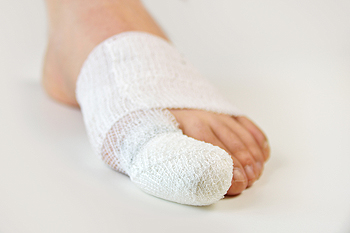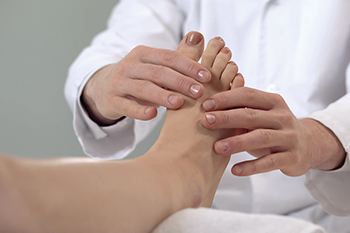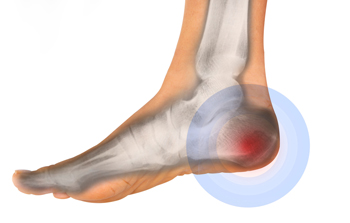Glen Allen Office
(804) 747-3380

Experiencing painful sensations in the feet can prove to be a big annoyance and something that might hinder your normal activities. For this reason, it is important to be aware of the many different types of pain you could experience—toe pain is one important kind. Toe pain has a variety of causes. One of the most common sources of toe pain is simply wearing ill-fitting footwear that is too tight around the toes. If you notice pain, swelling, and discoloration in one particular toe, this pain may be caused by a broken toe. Alternatively, if you are experiencing pain around the toenail (particularly at the sides of the nail), it is possible that this is due to an ingrown toenail. Lastly, if you have some kind of pain around the joint of a toe, and the skin around this area has become red in color or hot in temperature, this could be caused by gout. If you are unsure what is causing your toe pain, a podiatrist can help you identify and treat the problem.
Toe pain can disrupt your daily activities. If you have any concerns, contact one of our podiatrists of The Podiatry Center. Our doctors can provide the care you need to keep you pain-free and on your feet.
What Causes Toe Pain?
Most severe toe pain is caused due to a sports injury, trauma from dropping something heavy on the toe, or bumping into something rigid. Other problems can develop over time for various reasons.
Toe pain can be caused by one or more ailments. The most common include:
When to See a Podiatrist
Diagnosis
In many cases the cause of toe pain is obvious, but in others, a podiatrist may want to use more advanced methods to determine the problem. These can range from simple visual inspections and sensation tests to X-rays and MRI scans. Prior medical history, family medical history, and any recent physical traumatic events will all be taken into consideration for a proper diagnosis.
Treatment
Treatments for toe pain and injuries vary and may include shoe inserts, padding, taping, medicines, injections, and in some cases, surgery. If you believe that you have broken a toe, please see a podiatrist as soon as possible.
If you have any questions please feel free to contact one of our offices located in Richmond and Glen Allen, VA . We offer the newest diagnostic tools and technology to treat your foot and ankle needs.

The common reasons why people incur a broken toe is from dropping a heavy object on it, or stubbing it into a piece of furniture. Additionally, some patients may endure a toe injury, and the result may be a broken toe. Common symptoms that many people experience can include a popping sound as the toe snaps, and pain that becomes worse when the toe is moved. Additionally, bruising and swelling are common symptoms of a broken toe, and in severe cases, the affected toe may look deformed if it is displaced. A simple diagnosis consists of having an X-ray taken, and this can be helpful in determining how severely the toe is fractured. An effective treatment plan is called the buddy taping method, and this is done by taping the broken toe to the toe next to it. This is often successful in providing the stability that is needed as the healing process occurs. The foot and toe will feel better when it is frequently rested and elevated, and this may help to alleviate a portion of the swelling. If you have broken your toe, please schedule an appointment with a podiatrist as quickly as possible who can offer you a treatment method that is correct for you.
A broken toe can be very painful and lead to complications if not properly fixed. If you have any concerns about your feet, contact one of our podiatrists from The Podiatry Center. Our doctors will treat your foot and ankle needs.
What to Know About a Broken Toe
Although most people try to avoid foot trauma such as banging, stubbing, or dropping heavy objects on their feet, the unfortunate fact is that it is a common occurrence. Given the fact that toes are positioned in front of the feet, they typically sustain the brunt of such trauma. When trauma occurs to a toe, the result can be a painful break (fracture).
Symptoms of a Broken Toe
Generally, it is best to stay off of the injured toe with the affected foot elevated.
Severe toe fractures may be treated with a splint, cast, and in some cases, minor surgery. Due to its position and the pressure it endures with daily activity, future complications can occur if the big toe is not properly treated.
If you have any questions please feel free to contact one of our offices located in Richmond and Glen Allen, VA . We offer the newest diagnostic and treatment technologies for all your foot and ankle needs.

The amount of lower limb amputations is at an increased rate, and this is especially true of diabetic patients. High blood levels and poor glucose management can significantly contribute to the onset of diabetes which can lead to the amputation of a toe or a leg. An unnoticed cut on the bottom of the foot may lead to an infection that grows into a diabetic foot ulcer. This can be from the inability to heal properly, in addition to not keeping the weight off of the foot. There are methods that can be implemented which can help to eliminate the need for amputation. These can include controlling the body’s sugar levels, and having regular foot assessments performed by a podiatrist. Research has indicated this may help to reduce the risk of developing a foot ulcer by approximately 50%, which can lead to possible prevention of amputation. If you have diabetes, it is strongly suggested that you are under the care of a podiatrist, who can help you to properly manage this condition, and guide you toward methods in controlling your blood sugar.
Diabetic Limb Salvage
Diabetic limb salvage can be an effective way in preventing the need for limb amputation. If you have a foot ulcer and diabetes, consult with one of our podiatrists from The Podiatry Center. Our doctors will assess your condition and provide you with quality foot and ankle treatment.
What Is Diabetic Limb Salvage?
Diabetic limb salvage is the attempt of saving a limb, such as the foot, that has an infected ulcer, from amputation. Podiatrists also try to make sure that there is enough function in the foot after the salvage that it is still usable. Those with diabetes experience poor blood circulation, which prevents proper healing of an ulcer. If the ulcer is left uncheck, it could become infected, which could result in the need for amputation.
Diabetes is the number one cause of non-traumatic amputations in the United States. Amputation has been found to lead to higher mortality rates. This translates into higher healthcare costs, and a reduced quality of life and mobility for amputees. Podiatrists have attempted to increase the prevalence of limb salvage in an attempt to solve these issues.
Diagnosis and Treatment
Limb salvage teams have grown in recent years that utilize a number of different treatments to save the infected limb. This includes podiatrists that specialize in wound care, rehabilitation, orthotics, and surgery. Through a combination of these methods, limb salvage has been found to be an effective treatment for infected limbs, and as an alternative to amputation. Podiatrists will first evaluate the potential for limb salvage and determine if the limb can be saved or must be amputated.
If you have any questions, please feel free to contact one of our offices located in Richmond and Glen Allen, VA . We offer the newest diagnostic and treatment technologies for all your foot care needs.

The medical term for the foot condition known as an ingrown toenail is onychocryptosis. It is generally painful and may become infected if prompt treatment is not received. Ingrown toenails develop when the toenail grows into the skin instead of over it. The nail may grow into the skin as a result of wearing shoes that do not fit correctly or from trimming the toenails improperly. Many people have toenails that naturally curve, and this can occur due to genetic reasons. Patients who frequently participate in physical activities like ballet dancers, football players, and kickboxing experts may also experience this condition. Additionally, if you injure a toe, the result may be an ingrown toenail. Mild relief may be found when soaking the affected foot in warm water, followed by using a piece of cotton to gently pull the nail away from the skin. This is generally a temporary fix, and medical attention is often needed for complete healing. If you have endured an ingrown toenail, it is strongly advised that you consult with a podiatrist who can effectively treat this condition.
Ingrown toenails may initially present themselves as a minor discomfort, but they may progress into an infection in the skin without proper treatment. For more information about ingrown toenails, contact one of our podiatrists of The Podiatry Center. Our doctors can provide the care you need to keep you pain-free and on your feet.
Ingrown Toenails
Ingrown toenails are caused when the corner or side of a toenail grows into the soft flesh surrounding it. They often result in redness, swelling, pain, and in some cases, infection. This condition typically affects the big toe and may recur if it is not treated properly.
Causes
You are more likely to develop an ingrown toenail if you are obese, have diabetes, arthritis, or have any fungal infection in your nails. Additionally, people who have foot or toe deformities are at a higher risk of developing an ingrown toenail.
Symptoms
Some symptoms of ingrown toenails are redness, swelling, and pain. In rare cases, there may be a yellowish drainage coming from the nail.
Treatment
Ignoring an ingrown toenail can have serious complications. Infections of the nail border can progress to a deeper soft-tissue infection, which can then turn into a bone infection. You should always speak with your podiatrist if you suspect you have an ingrown toenail, especially if you have diabetes or poor circulation.
If you have any questions, please feel free to contact one of our offices located in Richmond and Glen Allen, VA . We offer the newest diagnostic and treatment technologies for all your foot care needs.

If you are a runner, then you are undoubtedly familiar with the importance of selecting the right kind of running shoes. The shoes that you select for runs can have a significant impact on your gait and running form. Selecting shoes that are ill-fitting may lead to injuries or foot complications. One important consideration to keep in mind when shopping for a pair of running shoes is what kind of terrain you will be running on. For example, if you run on roads or sidewalks, you can select road-running shoes. These shoes can be used to run on pavement, and they are built with cushioning that keeps the feet balanced when repeatedly striking hard surfaces. It is important to note that this type of shoe is made for running on mostly even surfaces. On the other hand, if you run on trails, then you might consider purchasing trail-running shoes. This kind of shoe is made to traverse uneven terrain and it has cleats on the outsole for gripping purposes. The midsoles on this kind of shoe tend to be stiffer to help navigate these uneven surfaces. If you are a runner, contact a podiatrist for tips on selecting the best pair of running shoes.
If you are a runner, wearing the right running shoe is essential. For more information, contact one of our podiatrists from The Podiatry Center. Our doctors can provide the care you need to keep you pain-free and on your feet.
Choosing the Right Running Shoe for Your Foot Type
To increase performance and avoid the risk of injury, it is important to choose the right running shoe based on your foot type. The general design of running shoes revolves around pronation, which is how the ankle rolls from outside to inside when the foot strikes the ground.
If you have any questions please feel free to contact one of our offices located in Richmond and Glen Allen, VA . We offer the newest diagnostic and treatment technologies for all your foot and ankle needs.

The movement of the body is referred to as biomechanics. Biomechanics of the feet refer to the movement of the feet and ankles. One of the functions of the ankle is to transfer the forces from the foot to the leg. Ligaments, muscles, and tendons connect the three bones that the ankle is made of and allow the foot to move up and down. The walk cycle, which is known as the gait, is divided into two phases known as the swing and stance phases. The former happens when the foot swings forward and is not in contact with the ground. The latter occurs when the foot hits the ground and this phase is split into three categories: heel strike, midstance, and heel lift. The heel strike allows the foot to roll inward known as pronation. This allows the foot to absorb the shock that comes from walking on different surfaces. The midstance allows the weight of the body to be directly over the foot as contact with the ground is made. When the foot rolls outward this describes the heel lift, and it activates the bones, muscles, and plantar fascia to work together as steps are taken. The foot is a complex structure and if you would like to learn more about how it works, please consult with a podiatrist.
If you have any concerns about your feet, contact one of our podiatrists from The Podiatry Center. Our doctors can provide the care you need to keep you pain-free and on your feet.
Biomechanics in Podiatry
Podiatric biomechanics is a particular sector of specialty podiatry with licensed practitioners who are trained to diagnose and treat conditions affecting the foot, ankle and lower leg. Biomechanics deals with the forces that act against the body, causing an interference with the biological structures. It focuses on the movement of the ankle, the foot and the forces that interact with them.
A History of Biomechanics
Modern technological improvements are based on past theories and therapeutic processes that provide a better understanding of podiatric concepts for biomechanics. Computers can provide accurate information about the forces and patterns of the feet and lower legs.
Understanding biomechanics of the feet can help improve and eliminate pain, stopping further stress to the foot.
If you have any questions please feel free to contact one of our offices located in Richmond and Glen Allen, VA . We offer the newest diagnostic and treatment technologies for all your foot and ankle needs.

A stress fracture is considered to be a hairline fracture. It can happen in the foot, and is often the result of participating in running and jumping activities. It occurs when the bones become fatigued, and cannot support the shock that comes from activity. It generally develops gradually, and many people tend to ignore the pain and discomfort that often accompanies this type of injury. Common symptoms that many patients notice include swelling at the end of the day, and it is difficult to walk as the fracture gets worse. Relief may be found when a boot is worn, and this may provide adequate support as the healing process occurs. This typically takes approximately six weeks, and is further evaluated to see if additional treatment is needed. Mild stretches may accelerate the healing process, which may be beneficial in strengthening the overall foot. If you have foot pain and feel it may be a stress fracture, please confer with a podiatrist as quickly as possible who can diagnose and treat this condition.
Stress fractures occur when there is a tiny crack within a bone. To learn more, contact one of our podiatrists from The Podiatry Center. Our doctors can provide the care you need to keep you pain free and on your feet.
How Are They Caused?
Stress fractures are the result of repetitive force being placed on the bone. Since the lower leg and feet often carry most of the body’s weight, stress fractures are likely to occur in these areas. If you rush into a new exercise, you are more likely to develop a stress fracture since you are starting too much, too soon. Pain resulting from stress fractures may go unnoticed at first, however it may start to worsen over time.
Risk Factors
Stress fractures do not always heal properly, so it is important that you seek help from a podiatrist if you suspect you may have one. Ignoring your stress fracture may cause it to worsen, and you may develop chronic pain as well as additional fractures.
If you have any questions, please feel free to contact one of our offices located in Richmond and Glen Allen, VA . We offer the newest diagnostic and treatment technologies for all your foot care needs.

There are many different causes of heel pain. One potential cause of your heel pain is known as a bruised heel. This condition essentially targets the skin and fat cushioning that protects the heel bone. Bruised heels can result from trauma that happens slowly over time, such as the repeated and sustained impact on the heel from running or jumping. However, bruised heels can also come about in response to a one-time traumatic injury. The most noticeable and prominent symptom of this condition is pain at the bottom of the heel bone, also known as the calcaneus. Importantly, the pain that is felt from a bruised heel is typically not as long-lasting as that felt from plantar fasciitis. Another symptom of bruised heels is a purple or red color on the heel. This discoloration is a sign of a bruise and results from bleeding that is happening underneath the skin. There are a variety of risk factors that can increase your likelihood of developing a bruised heel. For example, if you are significantly overweight or you run barefoot, then you might be more susceptible to developing a bruised heel. If you think that you may be suffering from this condition, reach out to a podiatrist who can help with treatment options.
Many people suffer from bouts of heel pain. For more information, contact one of our podiatrists of The Podiatry Center. Our doctors can provide the care you need to keep you pain-free and on your feet.
Causes of Heel Pain
Heel pain is often associated with plantar fasciitis. The plantar fascia is a band of tissues that extends along the bottom of the foot. A rip or tear in this ligament can cause inflammation of the tissue.
Achilles tendonitis is another cause of heel pain. Inflammation of the Achilles tendon will cause pain from fractures and muscle tearing. Lack of flexibility is also another symptom.
Heel spurs are another cause of pain. When the tissues of the plantar fascia undergo a great deal of stress, it can lead to ligament separation from the heel bone, causing heel spurs.
Why Might Heel Pain Occur?
Treatments
Heel pain should be treated as soon as possible for immediate results. Keeping your feet in a stress-free environment will help. If you suffer from Achilles tendonitis or plantar fasciitis, applying ice will reduce the swelling. Stretching before an exercise like running will help the muscles. Using all these tips will help make heel pain a condition of the past.
If you have any questions please contact one of our offices located in Richmond and Glen Allen, VA . We offer the newest diagnostic and treatment technologies for all your foot and ankle needs.